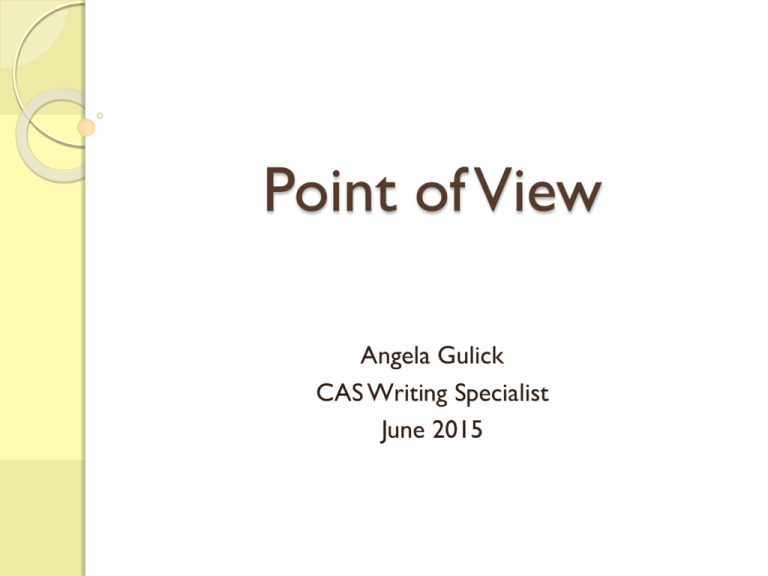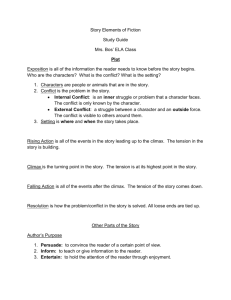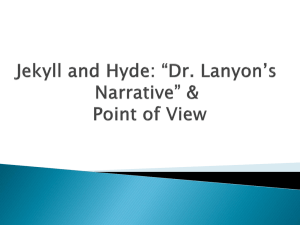Point of View
advertisement

Point of View Angela Gulick CAS Writing Specialist June 2015 Point of View Point of view refers to the relationship among the text, the writer, and the reader. There are three different points of view: first-person, second-person, and third-person. Sometimes a writer narrates information that he/she is actually a part of, sort of like an eye-witness report (firstperson point of view). Sometime, a writer speaks directly to the reader (secondperson point of view). Sometimes, a writer reports information as merely an objective observer, sort of like a newspaper article (thirdperson point of view). First-Person Point of View Point of View First-Person Pronouns Used I, me, my, mine, we, our, us, ours Focus The focus is on the author’s thoughts, opinions, and experiences. What we learn is what the author or, in the case of fiction, the narrator determines is important and has decided to share. What has the author/narrator decided not to share? Examples •diaries, personal letters, and personal email messages •wills (“I, Angela Gulick, being of sound mind and body,) and eyewitness testimony •works of fiction in which the narrator is part of the action. Effect on Readers Readers experience the information and events through the eyes and perceptions of the author/narrator. Therefore, readers may feel a close connection to the author/narrator, may trust what is being said. Readers should be aware that they might also be experiencing the biases, misperceptions, and prejudices of the author/narrator. Also, readers should ask what they are not being told by the author/narrator. In other words, what’s the agenda here? Second-Person Point of View Point of View Second-Person Pronouns Used you, your, you’re, yours, as well as direct commands such as “Speak,” “Jump,” “Sit down,” and “Do.” Focus The focus is on the reader of the information. The goal is to involve the reader, to help him/her feel directly involved in the information, to feel singled out. Examples •instructions and directions •political speeches (“Ask not what your country can do for you; ask what you can do for your country.”) •advertisements (“You deserve a break today.” “Be all that you can be.” “Just Do It.”) Effect on Reader Readers feel that they are being spoken to directly, and they may have a close connection to the author because readers are a direct part of the experience. Readers should also be aware that they might be experiencing some manipulation of the part of the author. Third-Person Point of View Point of View Third-Person Pronouns Used •pronouns (he/him/his, she/her/hers, it, they, them, their, they’re) •nouns (the hunter, the doctor, the president, that rabbit) •names (Sam, Dean, Bobby, Jo, Ellen, Cass, John, Mary, Rufus). Focus The focus is on the subject matter itself, not who is writing it (first-person) or who is reading it (second-person). The goal is to focus on the information by itself, to present “just the facts” without interpretation. Examples •college textbooks •magazine, newspaper, and journal articles •reports •works of fiction when the narrator is describing action from some external spot and is NOT part of the action Effect on Reader The focus is on the information itself and so there is a perception that the information is unbiased and purely factual. However, readers need to look at third-person point of view with just as much criticism and skepticism as any other text. Point-of-View Consistency Being consistent in terms of point of view is important because random switching around can confuse readers. Review this example: My all-time favorite summer activity is riding on a jet ski, and I love it when you feel the wind and spray in your face. The first part of this sentence begins in the first-person point of view (My all-time favorite activity, I love it...). The focus is on whoever is doing the action and the writing; we are learning about this person’s specific experience. The second part of the sentence abruptly switches to second-person point of view (when you feel the wind and spray in your face). Now the focus has switched to the reader, to making the reader a part of the experience. However, in this case, what happens if the reader (the “you”) has never been on a jet ski? The main problem with switches in point of view is that readers get confused on what they are to focus on – the writer? The reader him/herself? The subject matter? Being consistent with point of view throughout your document is your best strategy for clarity. Do You Still Have Questions? If you still have questions, please stop by the Writing Lab (D120) or check out our list of writing workshops on the CAS Resources page. Here are additional websites that can help you with grammar, punctuation, and mechanics issues. The first two links with ’s also have online exercises with answer keys to help you practice. Grammar Bytes Note: This site might require you to download a small program onto your computer the first time you use it. Guide to Grammar and Writing Purdue Online Writing Lab (OWL) Grammar Girl The Blue Book of Grammar







